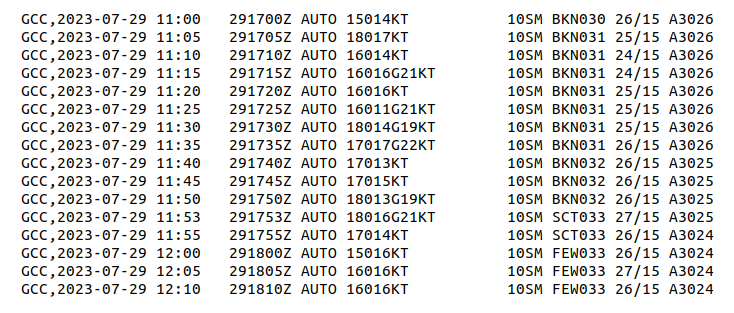
ASN Wikibase Occurrence # 318524
This information is added by users of ASN. Neither ASN nor the Flight Safety Foundation are responsible for the completeness or correctness of this information.
If you feel this information is incomplete or incorrect, you can submit corrected information.
| Date: | Saturday 29 July 2023 |
| Time: | 12:05 |
| Type: |  Cessna 177 Cardinal |
| Owner/operator: | High West Aero LLC |
| Registration: | N3357T |
| MSN: | 17700657 |
| Year of manufacture: | 1967 |
| Fatalities: | Fatalities: 0 / Occupants: 2 |
| Aircraft damage: | Substantial |
| Category: | Accident |
| Location: | near Gillette–Campbell County Airport (GCC/KGCC), Gillette, WY -
 United States of America United States of America
|
| Phase: | Initial climb |
| Nature: | Private |
| Departure airport: | Gillette-Campbell County Airport, WY (GCC/KGCC) |
| Livingston-Mission Field, MT (LVM/KLVM) | |
| Investigating agency: | NTSB |
| Confidence Rating: |
On July 29, 2023, about 1205 Mountain daylight time, a Cessna 177, N3357T, sustained substantial damage when it was involved in an accident near Gillette, Wyoming. The pilot and passenger sustained serious injuries. The airplane was operated as a Title 14 Code of Federal Regulations Part 91 personal flight.
The pilot reported that he and a passenger were on a multi-legged cross-country flight from Whitman Regional Airport (OSH), Oshkosh, Wisconsin, to Felts Airport, Spokane, Washington. Witnesses reported that the airplane had been fueled prior to takeoff from the Northeast Wyoming Regional Airport (GCC), Gillette. Witnesses observed the airplane depart runway 16 and reported that the engine seemed to be at full power with the flaps up.
The pilot reported that during takeoff, the airplane did not ascend as he expected. After the airplane crossed the departure end of the runway with rising terrain ahead, the pilot made a shallow right turn and elected to land in an open field as a precaution. Subsequently, the airplane impacted a hay bale during landing and the airplane came to rest nosed over. The pilot stated that he did not see the hay bale during the descent and flare. He added that he had previously executed takeoffs with full fuel during the trip.
Postaccident examination of the airplane revealed that the wings and fuselage sustained substantial damage. All the items onboard the airplane was removed and subsequently weighed, which totaled about 600 lbs.
The airplane was recovered to a secure facility for further examination.
---BEGIN PILOT'S NOTE---
I was PIC that day. With 16 kt of headwind, I rolled without flaps as the Horton STOL kit didn't need it on 7501' Runway 16. I expected to launch easily with such headwind. 6540' DA not excessive for takeoff, and I am used to such in the western summers.
The crash was not caused by weight, but wave action rotors and downdrafts. Winds were squirrely during taxi from 160-180 at 16G21KT, but seemed to have temporarily "calmed" to ~16KT straight down R16. Although I described to NTSB the rotor wave action from the strong southerly wind over the E/W ridgeline, such was not mentioned in the Preliminary Report. Takeoff and initial climb were were hampered by the rotors' "roof" and in retrospect I should have aborted T/O or landed on R16. (Moral: abort takeoff for ANYTHING out of the ordinary, taxi off the runway, and then figure it out on the ramp. Rejected landings are commonly practiced, but not aborted takeoffs.) I don't think I could have outclimbed those rotors even by myself and without baggage.
I couldn't clear the looming ridgeline to the South, and was on short emergency final to land in the only open pasture around (to the W/NW). That would have worked out OK, if not for a 1500+ fpm downdraft column at ~100' AGL. It was the strongest downdraft I've ever experienced, in any aircraft. I realized that impact was inevitable, and flared hard to null out as much of the push-down energy as possible. As the nose rose in the flare, I lost sight of the hayfield below that I was leaving, and the downdraft put the plane into a large hay bale which I couldn't see. Another 40' of forward travel would have cleared the plane of the field's last haybale and the fence.
Plane didn't stall, but was pushed down vertically, losing much of its glide slope. Impact was nearly flat, with wings level. Very sudden and dramatic. Down in about 3 seconds from 100' AGL. It felt like an elevator free-fall.
GCC is in a 3-walled bowl, open to the North. Traffic on R34 is most common, and doesn't present T/O issues. I've used Runway 16 before, but only with easterly winds (where the hills are fewer and lower). Southerly wind over the E/W ridge is damned funky and not to be trifled with.
---END PILOT'S NOTE---
Accident investigation:
 |
|
Sources:
https://www.gillettenewsrecord.com/news/local/article_9ad9b65f-70ab-506a-af0a-78237eb23b54.html
NTSB
FAA
Location
Images:

GCC DA of 6540 ft

GCC winds that day
Media:
NTSB investigating the crash of a Cessna 177 airplane near Gillette, Wyoming.
— NTSB Newsroom (@NTSB_Newsroom) July 30, 2023
Revision history:
| Date/time | Contributor | Updates |
|---|---|---|
| 31-Jul-2023 01:24 | Captain Adam | Added |
| 01-Aug-2023 08:05 | Captain Adam | Updated |
| 28-Mar-2024 06:47 | Downdraft Column | Updated [Narrative, Photo] |
| 28-Mar-2024 06:47 | Downdraft Column | Updated [Narrative, Photo] |
| 28-Mar-2024 08:40 | Downdraft Column | Updated [Phase] |
Corrections or additions? ... Edit this accident description
The Aviation Safety Network is an exclusive service provided by:


 ©2024 Flight Safety Foundation
©2024 Flight Safety Foundation